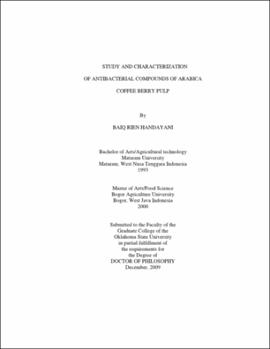| dc.contributor.advisor | Gilliland, Stanley E. | |
| dc.contributor.author | Handayani, Baiq Rien | |
| dc.date.accessioned | 2013-11-26T08:22:34Z | |
| dc.date.available | 2013-11-26T08:22:34Z | |
| dc.date.issued | 2009-12 | |
| dc.identifier.uri | https://hdl.handle.net/11244/6600 | |
| dc.description.abstract | Scope and Method of Study: | |
| dc.description.abstract | The objectives of this research were to determine the presence of antibacterial compounds, develop an efficient extraction method, analyze of phenolic contents, and measure their inhibitory effect against foodborne pathogens and spoilage bacteria. Antibacterial potential present in Hawaiian Arabica coffee berry pulp was determined using various extraction processes with water and methanol. Antibacterial activity of extracts was determined previously using turbidity method. Methanol extracts with 2 h reflux were further fractionated using chloroform, followed by ethyl acetate, then water and finally acidic methanol. All fractions were tested for antibacterial activity using disc method against foodborne pathogens and spoilage bacteria. Phenolics were identified using Reverse Phase-High Performance Liquid Chromatography. | |
| dc.description.abstract | Findings and Conclusions: | |
| dc.description.abstract | Water extract of coffee pulp showed potential antibacterial effect against E.coli 1472. Higher antibacterial activity was provided by 80 % methanol compared to water extraction. Further fractionation of 80 % methanol coffee pulp extract resulted 85 % of fractions recovery. Water soluble fraction exhibited significantly higher antibacterial activity than chloroform and ethyl acetate fractions. Water soluble fractions showed similar inhibition activity against E.coli O157:H7 strains. Pseudomonas fluorescens was the most sensitive bacteria to water soluble fractions. Listeria monocytogenes strains were more susceptible to chloroform fractions than all others bacteria tested. Caffeine was observed as a dominant phenolic. Chloroform was able to extract the highest amount of caffeine (705 g/g wet pulp). Chlorogenic acid, caffeic acid, and p -coumaric acid were detected in ethyl acetate and water soluble fractions. Results indicated there were antibacterial compounds present in the pulp. In conclusion, Hawaiian Arabica coffee berry pulp may useful as a food preservative. | |
| dc.format | application/pdf | |
| dc.language | en_US | |
| dc.rights | Copyright is held by the author who has granted the Oklahoma State University Library the non-exclusive right to share this material in its institutional repository. Contact Digital Library Services at lib-dls@okstate.edu or 405-744-9161 for the permission policy on the use, reproduction or distribution of this material. | |
| dc.title | Study and characterization of antibacterial compounds of Arabica coffee berry pulp | |
| dc.contributor.committeeMember | Manness, Niels O. | |
| dc.contributor.committeeMember | McGlynn, William G. | |
| dc.contributor.committeeMember | DeWitt, Christina A. Mireles | |
| osu.filename | Handayani_okstate_0664D_10542 | |
| osu.accesstype | Open Access | |
| dc.type.genre | Dissertation | |
| dc.type.material | Text | |
| dc.subject.keywords | antibacterial | |
| dc.subject.keywords | arabica coffee | |
| dc.subject.keywords | coffee berry pulp | |
| thesis.degree.discipline | Food Science | |
| thesis.degree.grantor | Oklahoma State University | |
